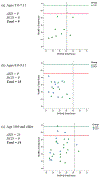Shared Features or Co-occurrence? Evaluating Symptoms of Developmental Coordination Disorder in Children and Adolescents with Autism Spectrum Disorder
- PMID: 33387238
- PMCID: PMC10177628
- DOI: 10.1007/s10803-020-04766-z
Shared Features or Co-occurrence? Evaluating Symptoms of Developmental Coordination Disorder in Children and Adolescents with Autism Spectrum Disorder
Abstract
Motor differences are common in Autism Spectrum Disorder (ASD), but rarely evaluated against diagnostic criteria for Developmental Coordination Disorder (DCD). We aimed to determine whether motor problems in ASD represent the possible co-occurrence of DCD. We retrospectively reviewed standardized assessments and parent-reports to evaluate motor ability in 43 individuals with ASD against diagnostic criteria for DCD, and compared to 18 individuals with DCD. Over 97% of cases in the ASD group scored below the 16th percentile in motor ability, with most below the 5th percentile. Over 90% of cases in the ASD group met criteria for co-occurring DCD. Motor challenges are a clinically-significant problem in ASD; systematically assessing the prevalence of co-occurring ASD + DCD is necessary to optimize assessment and intervention.
Keywords: Autism spectrum disorder; Comorbidity; Developmental coordination disorder; Motor control; Neurodevelopmental disorder.
© 2021. Springer Science+Business Media, LLC, part of Springer Nature.
Conflict of interest statement
Figures


References
-
- Allen KA, Bredero B, Van Damme T, Ulrich DA, & Simons J (2017). Test of gross motor development-3 (TGMD-3) with the use of visual supports for children with autism spectrum disorder: validity and reliability. Journal of Autism and Developmental Disorders, 47(3), 813–833. - PubMed
-
- American Psychiatric Association. (1980). Diagnostic and statistical manual of mental disorders (3rd ed.). Washington, DC: Author.
-
- American Psychiatric Association. (1987). Diagnostic and statistical manual of mental disorders (3rd ed.). Washington, DC: Author.
-
- American Psychiatric Association. (1994). Diagnostic and statistical manual of mental disorders (4th ed.). Washington, DC: Author.
MeSH terms
Grants and funding
LinkOut - more resources
Full Text Sources
Other Literature Sources
Medical
Miscellaneous

